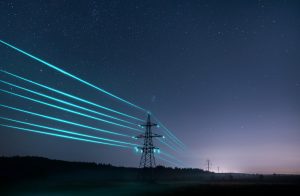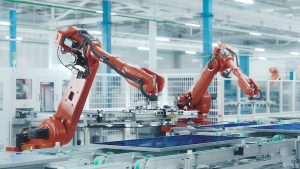A Variable Speed Drive (VSD) is obviously able to run a motor at variable speeds, but it is also a smart actuator, fully capable of being connected and integrated into different systems: Automation, Safety or Power Conversion.
It’s able to act hierarchically at all the levels of the application system: electrical, mechanical and process by protecting, controlling, and monitoring physical equipment: pump systems, machines, conveyors, cranes, etc.
This is why the variable speed drive is not only just a drive:
It’s a power conversion product
A Drive is a frequency converter, if we look at its input/output. It is able to deliver full current from 0 to 599Hz, but also up to 2000Hz as a fundamental frequency. As a power conversion product realized with multiple converters:
- It is basically a rectifier bridge (aka AC/DC power converter), with or without regenerative capabilities, with or without low harmonics level
- DC/DC power converter, and inverter bridge (aka DC/AC power converter), with 2-levels or more
It’s possible to electrically connect drives together, for instance through DC bus sharing architecture, but also to use the power converter as bricks to optimize the power conversion solution, connecting them in series or in parallel. DC filter, AC filter, dv/dt filter, EMC filter, Sinus filter, etc. are options that are able to adapt power conversion architectures.
So, yes, a Drive is a power conversion product, but not only.
It’s an automation safe product
A Drive is a connectable low level controller because of its embedded capability for fieldbus communication, or wired solutions. Insulated from power mains supply, it’s a safe and certified device. Its firmware can be updated, configured and programmed locally with external devices such as a keypad, PC, smartphone and controllers. It can store data from its environment and exchange it with connected devices. It can also be embedded with a dedicated communication link to exchange data between drives in an optimal and transparent way.
So, yes, a Drive is an automation safe product, but not only.
It’s a local HMI product
You can quickly start a drive configuration for an application. This can be stored and applied to other drives. You can start, stop, and locally reset a Drive, monitor the application and alert the user.
So, yes, a Drive is an HMI product but not only.
It’s an electrical motor control solution
Electrical machines are universally build in two parts; fixed (stator) and rotating (rotor) that convert power from electrical to mechanical. The behavior is driven by fundamental physics and does not depend on motor makers. Thanks to a physical model approach, a Drive can control all types of electrical machines (induction motors, surfaced/internal permanent magnet motors, and synchronous reluctant motors). It addresses mainly three-phase sinusoidal motors but it is not a physical limitation; with or without a sensor. According to the flux vector control principle, a Drive optimizes the electrical machine energy consumption and simultaneously maximizes the mechanical power capability. The settings functions (manually through nameplate or automatic through auto-tuning) complete the Electrical Motor Control approach.
So, yes, a Drive is an Electrical Motor Control solution, but not only.
It’s a mechanical control solution
As discussed above, a motor is a power converter from an electrical domain to a mechanical domain. The mechanical domain is managed by the fundamental principle that links position, speed, torque, and jerk through dynamic equations. The Drive embeds all types of mechanical control and sequence principles to address torque, speed and position needs for rigid, flexible load and also hybrid load as toothed gear, with gearbox, with mechanical brake. A Drive can also share the torque realization on mechanical coupling, in multiple drive equipment architecture (Client/Server application).
So, yes, a Drive is a mechanical control solution, but not only.
It’s an application control solution
A Drive is application oriented, as it is embedded with main application functions (for pump management, for compressor, for fan, etc.) and also by being a flexible environment. Thanks to a model-based approach, application control functions dealing with application/process variables (flow, pressure, diameter, distance, etc.) can be managed on an individual basis by an R&D team to answer specific needs, such as creation of a new application program and corresponding embedded drive unitary functions.
So, yes, a Drive is an application control solution, but not only.
Until now a Drive has been known as a VSD (Variable Speed Drive).
In a service-oriented and solution approach, the variable speed drive has grown up to become something much more: an optimized energy drive (OED), acting efficiently to command, protect, connect and monitor in every field it is used.
Is it time for a name change?




Conversation
Very nice explanation! And I fully agree with you, the drive is much more than a motor control device!
Thanks Delcho for your comment and your interest !
Yes, much more than a motor control device.
After the power electronics, and the motor control, a new pillar is emerging in a Drive: the system integration.
This last one is not specific to a Drive, but, thanks to the Drive capabilities, a Drive is a key actor for
– the energy control for the motor and its application
– the energy monitoring to support high level decisions,
– and the safe protection for energy usage,
and has to be fully integrated into safe automation systems.
We could say that VSD is become an Optimized Energy Drive.
What an article on drive.
thanks for this post.
Thanks for your interest in this post.
François.
Excellent article Francois,
Will be interesting to see how VSD enhances services can be part of a larger industrial ecosystem.
Today called IIoT.
Can VSD be a” thing” ? a smart object?
VSD have the capacity to collect massive quantity of application data, and compute them in valuable information, and have the needed communication interfaces.
Can the VSD became a software modernization “Object” of the real system? a pump or fan?
The future to come
Marco, thanks for your comment !
You are right, the Drive’s integration in automation systems is a key feature for Drive; from the automation systems point of view, the Drive is an object that
\ controls power conversion equipment, electrical motors, mechanical systems, etc.
\ collects data for protection, monitoring -and control-
The Data treatment can be done locally or remotely in case of a single actuator, or a system with multiple actuators.
A drive is a smart object in complex control systems, and an enabler for advanced services though analytics, for instance.
François
Exellent post, I agree, your post of variable speed drives to relate of AC drives and DC drives.
Thanks for your comment.
A hierarchical approach and integration into systems (power/automation) are true for all types of Drives.
François.
Thank you sharing this post. You have explained everything so nicely and I agree with you totally. We want more posts like this. Very nice!
Thanks for your interest in this post.
François.